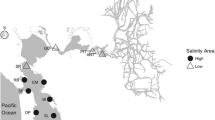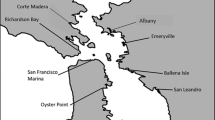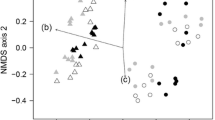Abstract
The spatial patterns of nonindigenous species in seven subtidal soft-bottom communities in the San Francisco Estuary were quantified. Sixty nonindigenous species were found out of the 533 taxa enumerated (11%). Patterns of invasion across the communities were evaluated using a suite of invasion metrics based on the abundance or species richness of nonindigenous species. Patterns of invasion along the estuarine gradient varied with the invasion metric used, and the ecological interpretation of the metrics is discussed. Overall, the estuarine transition community located in the estuarine turbidity maximum zone (mean 5 practical salinity unit (psu)), main estuarine community (mean 16 psu), and marine muddy community (mean 28 psu) were more invaded than two fresh-brackish communities (mean < 1 psu) and a marine sandy community (mean 27 psu). Nonindigenous species were numerically dominant over much of the Estuary, making up more than 90% of the individuals in two communities. The percentage of the total species composed of nonindigenous species increased at smaller spatial scales: 11% at the estuary (gamma) scale, 21% at the community (alpha) scale, and 42% at the grab (point) scale. Wider spatial distributions of nonindigenous species and a relatively greater percentage of rare native species may have resulted in this pattern. Because of this scale dependency, comparisons among sites need to be made at the same spatial scale. Native species were positively correlated with nonindigenous species in several of the communities, presumably due to similar responses to small-scale differences in habitat quality. The rate of invasion into the soft-bottom communities of the San Francisco Estuary appears to have increased over the last one to two decades and many of the new introductions have become numerically dominant.
Similar content being viewed by others
References
Aline AE and Cloern JE (1992) Trophic interactions and direct physical effects control phytoplankton biomass and production in an estuary. Limnology and Oceanography 37: 946–955
Bially A and MacIsaac HJ (2000) Fouling mussels (Dreissena spp.) colonize soft sediments in Lake Erie and facilitate benthic invertebrates. Freshwater Biology 43: 85–97
Bray J and Curtis J (1957) An ordination of the upland forest communities of southernWisconsin. Ecological Monographs 27: 325–349
Carlton JT (1996) Biological invasions and cryptogenic species. Ecology 77: 1653–1654
Carlton JT, Thompson J, Schemel L and Nichols FH (1990) Remarkable invasion of San Francisco Bay (California, USA) by the Asian clam Potamocorbula amurensis. I. Introduction and dispersal. Marine Ecology Progress Series 66: 81–94
Carey D, Oliver J and Iampietro P (1994) Amphipod toxicity and benthic community analysis. In: San Francisco Estuary Pilot Regional Monitoring Program: Sediment Studies, Final Report for the San Francisco Regional Water Quality Control Board and the StateWater Resources Control Board, Sacramento, California
Case TJ (1990) Invasion resistence arises in strongly interacting species-rich model competition communities. Proceedings of the National Academy of Sciences, USA 887: 9610–9614
Castillo GC (2000) Benthic biological invasions in two temperate estuaries and their effects on trophic relations of native fish and community stability. Doctoral dissertation, Oregon State University, 251 pp
Castillo GC, Li HW and Rossignol PA (2000) Absence of overall feedback in a benthic estuarine community: a system potentially buffered from impacts of biological invasions. Estuaries 23: 275–291
Chapman J (2000) Climate effects on the geography of nonindigenous peracaridan crustacean introductions in estuaries. In: Pederson J (ed) Proceedings of the First International Conference on Marine Bioinvasions, pp 66–80. MIT, Cambridge, Massachusetts
Cohen AN (1998) Ship's BallastWater and the Introduction of Exotic Organisms into the San Francisco Estuary: Current Status of the Problem and Options for Management. San Francisco Estuary Institute, Oakland, California, 81 pp
Cohen AN and Carlton JT (1995) Nonindigenous aquatic species in a United States estuary: a case study of the biological invasions of the San Francisco Bay and Delta. Report for the National Sea Grant College Program, Connecticut and theUSFish andWildlife Service, Washington, DC, Report no. PB 96-166525
Cohen AN and Carlton JT (1998) Accelerating invasion rate in a highly invaded estuary. Science 279: 555–558
Cohen AN, Mills CE, Berry H, Wonham MJ, Bingham B, Bookeim B, Carlton JT, Chapman JW, Cordell JR, Harris LH, Klinger T, Kohn A, Lambert CC, Lambert G, Li K, Secord D and Toft J (1998) Report of the Puget Sound Expedition, September 8–16, 1998: a rapid assessment survey of nonindigenous species in the shallow water of Puget Sound. For the Washington State Department Natural Resources, Olympia, Washington, and the US Fish and Wildlife Service, Lacey, Washington, 37 pp
Elton CS (1958) The Ecology of Invasions by Animals and Plants. Methuen, London
Forsyth DM and Duncan RP (2001) Propagule size and relative success of exotic ungulate and bird introductions to New Zealand. American Naturalist 157: 583–595
Gower J (1966) Some distance properties of latent root and vector methods used in multivariate analysis. Biometrica 53: 325–338
Gower J (1967) Multivariate analysis and multidimensional geometry. The Statistician 17: 13–28
Hunt JW, Anderson BS, Phillips BM, Newman J, Tjeerdema R, Stephenson M, Puckett M, Fairly R, Smtih RW and Taberski K (1998) Evaluation and use of sediment reference sites and toxicity tests in San Francisco Bay. Final report for California StateWater Resources Control Board, Sacramento, California
Jaccard J and Wan CK (1996) LISREL Approaches to Interaction Effects in Multiple Regression. Sage Publications, Thousand Oaks, California
Jackson LE, Kurtz JC and Fisher WS (eds) (2000) Evaluation Guidelines for Ecological Indicators US EPA, EPA/620/R-99/005, 107 pp
Kimmerer WJ, Gartside E and Orsi JJ (1994) Predation by an introduced clam as the probable cause of substantial declines in zooplankton in San Francisco Bay. Marine Ecology Progress Series 113: 81–93
Kolar CS and Lodge DM (2001) Progress in invasion biology: predicting invaders. Trends in Ecology and Evolution 16: 199–204
Lance G and Williams W (1966) A generalized sorting strategy for computer classifications. Nature 212: 218–225
Levin L (1984) Life history and dispersal patterns in a dense infaunal polychaete assemblage: community structure and response to disturbance. Ecology 65: 1185–1200
Levine JM (2000) Species diversity and biological invasions: relating local process to community pattern. Science 288: 852–854
Levine JM and D'Antonio C (1999) Elton revisited: a review of evidence linking diversity and invasibility. Oikos 87: 15–26
MacArthur RH (1972) Geographical Ecology: Patterns in the Distributions of Species. Harper and Row, New York
Mack R, Simberloff D, Lonsdale WM, Evans H, Clout M and Bazzaz F (2000) Biotic invasions: causes, epidemiology, global consequences and control. Ecological Applications 10: 689–710
Magurran A (1988) Ecological Diversity and Its Measurement. Princeton University Press, Princeton, New Jersey, 179 pp
Meng L, Moyle P and Herbold B (1994) Changes in abundance and distribution of native and introduced fishes of Suisun Marsh. Transactions of the American Fisheries Society 123: 498–507
Nichols FH and Pamatmat MM (1988) The ecology of the softbottom benthos of San Francisco Bay: a community profile. US Fish and Wildlife Service Biological Report 85, 73 pp
Nichols FH and Thompson JK (1985a) Persistence of an introduced mudflat community in South San Francisco Bay, California. Marine Ecology Progress Series 24: 83–97
Nichols FH and Thompson JK (1985b) Time scales of change in the San Francisco Bay benthos. Hydrobiologia 120: 121–138
Nichols FH, Thompson JK and Schemel LE (1990) Remarkable invasion of San Francisco Bay (San Francisco, CA) by the Asian Clam Potamocorbula amurensis. II. Displacement of a former community. Marine Ecology Progress Series 66: 95–101
Pimentel D, Lach L, ZunigaRand Morrison D (2000) Environmental and economic costs associated with non-indigenous species in the United States. Bioscience 50: 53–65
Ruiz G, Carlton J, Grosholz E and Hines A (1997) Global invasions of marine and estuarine habitats by non-indigenous species: Mechanisms, extent, and consequences. American Zoologist 37: 621–632
Ruiz G, Fofonoff P, Carlton J, Wonham M and Hines A (2000) Invasion of coastal marine communities in North America: Apparent patterns, processes, and biases. Annual Review of Ecology and Systematics 31: 481–531
Sakai AK, Allendorf FW, Holt JS, Lodge DM, Molofsky J, With KA, Baughman S, Cabin RJ, Cohen JE, Ellstrand NC, McCauley DE, O'Neil P, Parker IM, Thompson JN and Weller SG (2001) The population biology of invasive species. Annual Review of Ecology and Systematics 32: 305–332
Scott JM and Jennings MD (1998) Large-area mapping of biodiversity. Annals of Missouri Botanical Garden 85: 34–47
Smith RW, Bernstein BB and Cimberg RL (1985) Community– environmental relationships in the benthos: application of multivariate analytical techniques. In: Soule DF and Kleppel GS (eds) Marine Organisms as Indicators, pp 247–326. Springer-Verlag, New York
Snelgrove PV and Butman CA (1994) Animal–sediment relationships revisited: cause versus effect. Oceanography and Marine Biology Annual Reviews 32: 111–117
Sorensen T (1948) A method of establishing groups of equal amplitude in plant sociology based on similarity of species count. Biologiske Skrifter 5: 1–34
Thompson B, Lowe S and Gravitz L (1999) Sediment conditions near wastewater discharges in San Francisco Bay. Report to Bay Area Discharger's Association, San Francisco Estuary Institute, Richmond, California, 40 pp
Thompson B, Lowe S and Kellogg M (2000) Results of benthic pilot study 1994–1997. Part I – macrobenthic assemblages of the San Francisco Bay-Delta, and their responses to abiotic factors. San Francisco Estuary Institute Technical report 39, 40 pp
Walters R, Cheng R and Conomos J (1985) Time scales of circulation and mixing processes of San Francisco Baywaters. Hydrobiologia 129: 13–36
Westbrooks R (1998) Invasive Plants, Changing the Landscape of America: Fact Book. Federal Interagency Committee for the Management of Noxious and Exotic Weeds (FICMNEW), Washington, DC, 109 pp
Whittaker RH (1977) Evolution of species diversity in land communities. In: Hecht MK, Steere WC and Wallace B (eds) Evolutionary Biology, Vol 10, pp 1–67. Plenum, New York
Wolff W (1999) Exotic invaders of the meso-oligohaline zone of estuaries in The Netherlands: why are there so many? Helgoländer Meeresuntersuchungen 52: 393–400
Author information
Authors and Affiliations
Corresponding author
Rights and permissions
About this article
Cite this article
Lee, H., Thompson, B. & Lowe, S. Estuarine and scalar patterns of invasion in the soft-bottom benthic communities of the San Francisco Estuary. Biological Invasions 5, 85–102 (2003). https://doi.org/10.1023/A:1024038522256
Issue Date:
DOI: https://doi.org/10.1023/A:1024038522256




